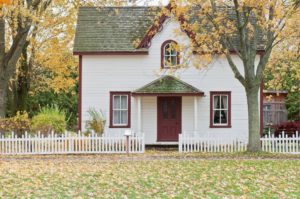 Throughout the western US, especially in California, widespread damage from catastrophic wildfires has increased in both frequency and scale in the past 10-15 years. Whether attributable to climate change or other factors, it’s undeniable. The fall of 2018 was particularly bad, with the horrific Camp Fire killing dozens and leveling the entire community of Paradise in northern California. Life will never be the same for those hardest hit by wildfire devastation.
Throughout the western US, especially in California, widespread damage from catastrophic wildfires has increased in both frequency and scale in the past 10-15 years. Whether attributable to climate change or other factors, it’s undeniable. The fall of 2018 was particularly bad, with the horrific Camp Fire killing dozens and leveling the entire community of Paradise in northern California. Life will never be the same for those hardest hit by wildfire devastation.
Of all the western states, California has long been associated with the threat of “The Big One”, the mother-of-all-earthquakes that could hit the state at any time. While that could happen, most Californians would probably say that wildfires pose a bigger danger to residents. Certainly, there has been ample proof recently.
So, with the 2019 wildfire season looming, it’s important for you to make sure your home is as prepared as possible to survive the unthinkable. Here’s what you can do to have a more fireproof house this summer.
1. Survey Your Home’s Perimeter and Surrounding Area
The National Academy of Sciences did a study in 2017 which concluded that 84% of wildfires in the US are started by human activity of some sort. Just one little spark, when combined with dry trees or brush and strong winds, can erupt into a blazing inferno that can scorch hundreds or thousands of acres.
While you have no control over the carelessness of others, you can take positive action toward increasing the odds your property will survive. Fireproofing your home starts at the perimeter of your yard and works in toward your house itself. Experts recommend you establish 100 feet of distance and/or non-flammable material (termed “defensible space“) between your house and the wildlands.
That could include your driveway, patio(s), pathway(s), and/or fire retardant ground cover plants. So, let’s take a look outside…
Remove any dry or dead vegetation
This includes grass, leaves, weeds, pine needles, etc. If you can’t remove this debris, at least thoroughly wet it down.
Keep low tree branches trimmed
Conifers (pines or firs) contain a sap that is extremely flammable. It can act as an accelerant to an already dangerous fire. These trees ideally shouldn’t be located next to your house. Keep all branches trimmed at least 6 feet above the ground.
Plant fire-resistant vegetation near your house
Certain plants like yucca, agave, lilac, lavender, and ice plant are naturally fire retardant. Not all plants are suitable to grow in all areas. Check your growing zone to see if these plants are compatible with your region. The best ground cover plants are low-resin and high in moisture content.
Maintain your lawn properly
Lawns in most parts of the US go dormant in the winter, leaving dry grass on the surface. Rake up dead grass before fire season. Keep the lawn cut short (max height 4 inches) and keep it well-watered.
Keep trash contained and all trash receptacles away from the house
Combustible trash like cereal boxes, newspapers, etc can really be a danger if there are hot embers being blown about by a wildfire. Make sure to pick up trash and litter in your yard and put in a covered container located away from the house if possible.
Make sure firetrucks can get to your home when needed
If a firetruck can’t access your home, firefighters can’t put the fire out. That’s a sobering thought, but true. A firetruck needs an unobstructed path to your house, including your driveway. If you have a privacy gate, you need to plan for that.
You must ensure that your driveway is solid enough to support a firetruck. If there are cracks or soft spots, you should get them repaired. It’s also beneficial to have a good space for the firetruck to turn around. Just something to think about.
2. Inspect Your House
Now that you’ve got the yard and the area around your house taken care of, let’s look at your house itself.
Remove debris from your roof and gutters regularly
Embers from a wildfire can travel a mile or more, depending on wind conditions. If hot embers land on your roof and you have dead leaves, pine needles or other flammable debris up there, it can spell trouble, even if your roof is fire-resistant.
De-clutter your home
Let’s be honest, most people have “stuff” in their homes that they no longer need or use. This can be fodder for a fire to spread if a spark makes it inside your house. Inspect and ensure that your “stuff” is indeed important to you.
Install smoke alarms and check them regularly
Smoke detectors/alarms reduce your family’s risk of dying in a fire by 50%. A smoke detector should be installed in every bedroom, as well as in the hallway on each floor of your house.
Smoke rises, so place the detectors high on the wall or on the ceiling. It’s a great idea to change the battery (usually a 9V alkaline cell) in each detector when you change your clocks from Standard Time to Daylight Savings Time and vice versa.
In other words, change the batteries every six months and test once per month.
Have at least one fire extinguisher on each floor
The best location for the main floor is usually the kitchen, since that is where many fires inside the home get started. Make sure everyone in your family knows how to use the extinguisher. Remember the acronym PASS:
- Pull the safety pin
- Aim at the base of the fire
- Squeeze the lever on the handle
- Sweep the nozzle from side to side at the base of the fire
Many fire extinguishers have a gauge on them indicating whether they are viable or not. Make sure yours are ready to go if needed.
Store a fire ladder in each adult’s bedroom
Fire ladders are lightweight, usually made of aluminum, and are collapsible for compact storage. Such a ladder can help your family escape from a second-story window, with adults helping young children to get out.
Have a family plan for a fire emergency
Your family should know and rehearse ahead of time the best ways to evacuate your house in the event of a fire. You should try to have both a primary and an alternate way out of each room and make sure each route is accessible.
Have a pre-designated meeting area for your family to gather after getting out of the house. You should also have a backup spot that everyone knows about.
Finally, you need to plan how you would best exit your property or your neighborhood if a large wildfire was bearing down on you. It’s a stressful situation. and your ability to remain calm will be enhanced if you have thought it out.
What If Your Fireproof House…Isn’t?
Despite your best efforts to have a fireproof house, bad things still happen to good people. Your house could still suffer fire damage during a wildfire, but BMS CAT can help! We are experts in fire and smoke damage restoration. Contact us today.
